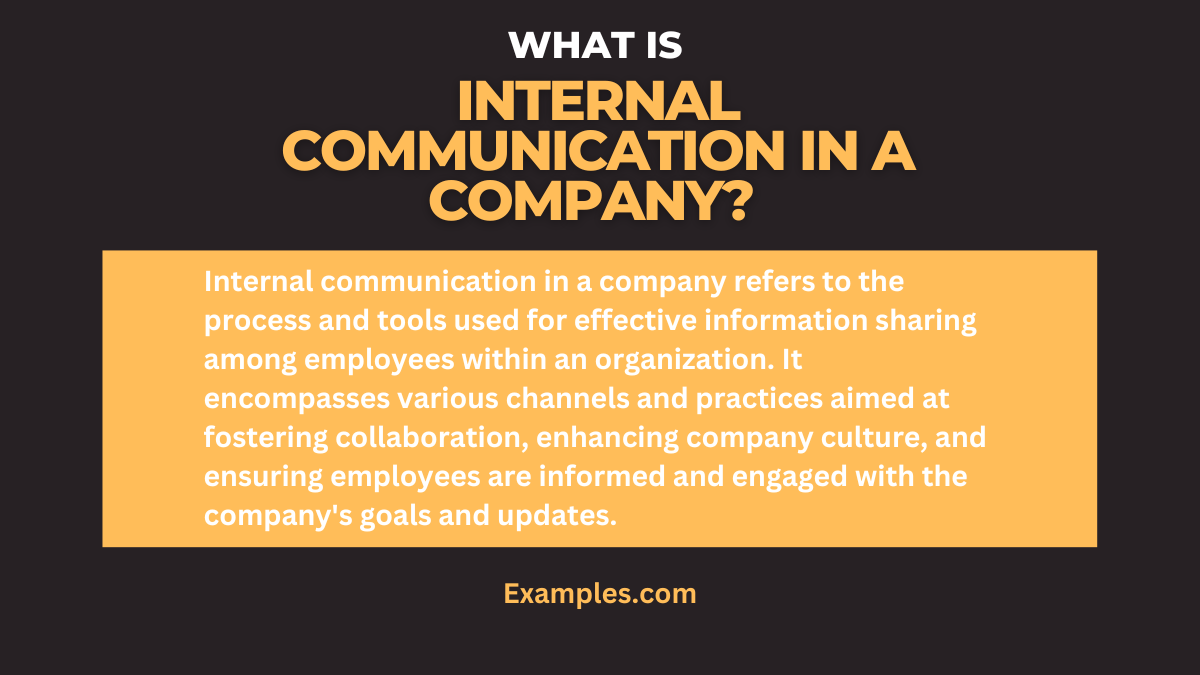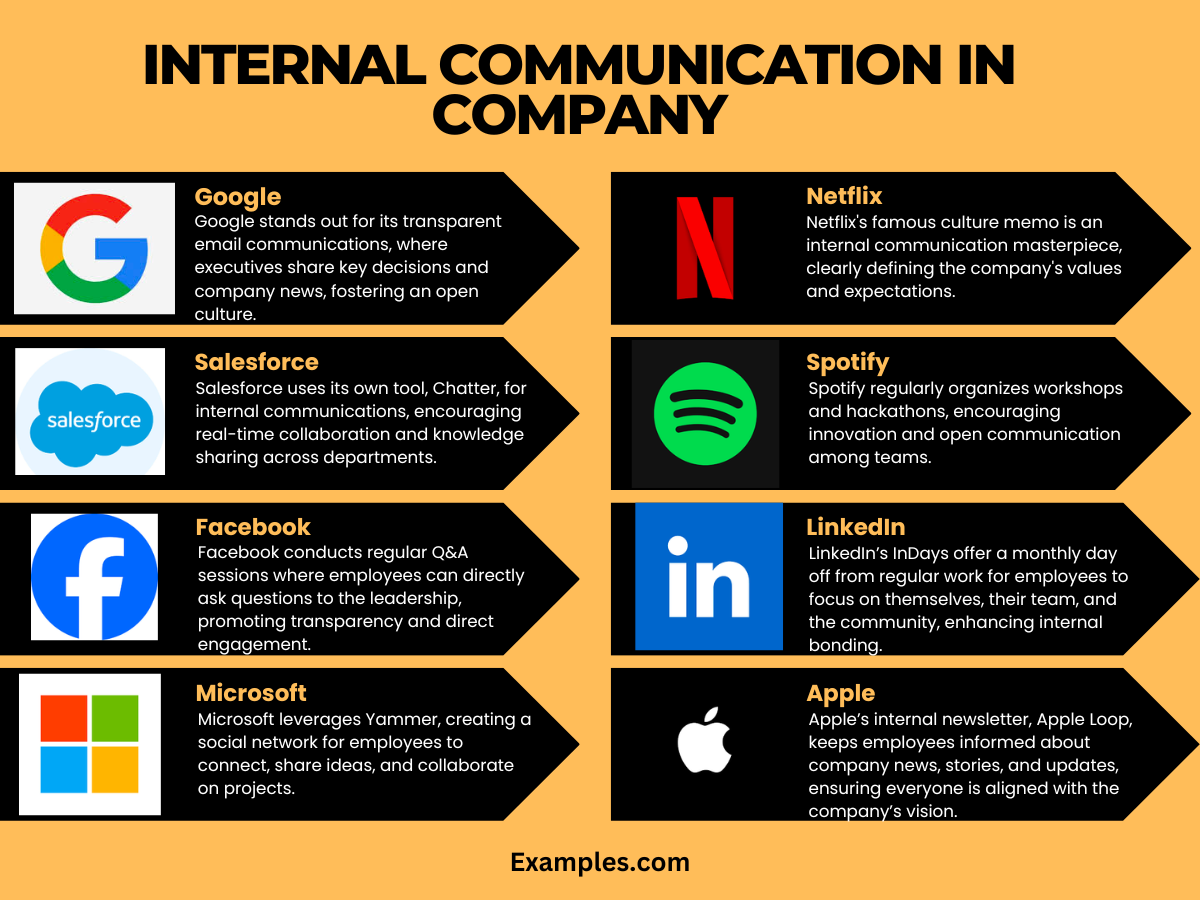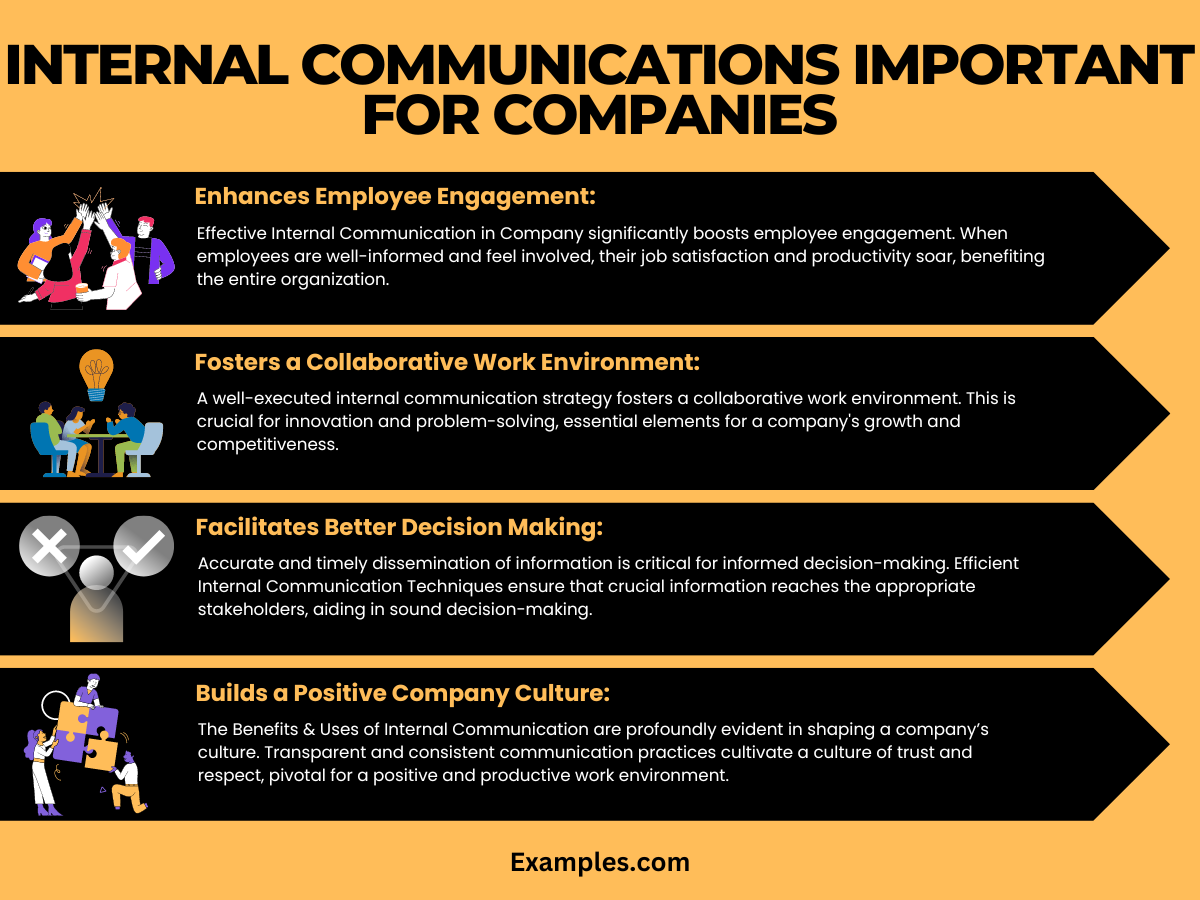10 Internal Communication in Company Examples
Dive into the world of internal communication in companies, a key ingredient for organizational success. This comprehensive guide illuminates the various aspects and Internal Communication Examples, demonstrating how effective dialogue can transform company culture. From traditional memos to digital platforms, explore how diverse communication methods foster collaboration and boost productivity. Whether you’re a start-up or an established entity, these insights are vital for enhancing your internal communication strategies.
What is Internal Communication in a Company? – Definition

Internal communication in a company refers to the way information is shared among the people within the organization. It’s about how employees talk to each other, share ideas, and work together. This communication can take many forms, like meetings, emails, or a chat on a company’s app. Understanding Internal Communication Functions and Types of Internal Communication is key. Good internal communication helps everyone understand their roles and stay informed, making the company work better as a whole.
Examples of Great Internal Communication in Company
Explore how industry leaders like Google, Salesforce, Facebook, and Microsoft excel in internal communication. These corporations demonstrate innovative and effective Internal Communication Techniques and Internal Communication Best Practices. Their approaches range from digital platforms that encourage collaboration to unique cultural initiatives that foster transparency and employee engagement.

Google – Transparent Email Updates:
Google’s strategy for internal communication revolves around transparency. Leadership sends frequent emails detailing key company updates, decisions, and strategic directions. This approach fosters an inclusive and informed workplace culture, ensuring every team member feels connected to the company’s broader objectives.
Salesforce – Chatter Platform:
Salesforce enhances internal communication with its Chatter platform. It’s a unique digital space that allows employees to engage in real-time discussions, share insights, and collaborate across departments. This tool helps break down silos and fosters a strong sense of community and teamwork within the company.
Facebook – Internal Q&A Sessions:
Facebook promotes a culture of openness through regular Q&A sessions. These sessions enable employees to directly engage with the leadership, ask questions, and provide feedback. This initiative not only ensures transparency but also helps in building trust and aligning employees with the company’s vision.
Microsoft – Yammer Networks:
At Microsoft, Yammer serves as a pivotal tool for internal communication. It acts as an internal social network, connecting employees globally. This platform encourages sharing of ideas, collaboration on projects, and helps in creating a more inclusive and connected company culture.
Netflix – Culture Memo:
Netflix has set a benchmark with its detailed culture memo. This document clearly articulates the company’s values, expectations, and operational principles. It’s a cornerstone for internal communication, ensuring all employees understand and align with Netflix’s unique culture and business approach.
Spotify – Workshops and Hackathons:
Spotify uses workshops and hackathons as a means of fostering open communication and innovation. These events encourage employees from different departments to collaborate, share ideas, and develop new solutions, thus promoting a culture of creativity and continuous learning.
LinkedIn – InDays:
LinkedIn’s innovative InDays concept offers employees a break from routine work. This monthly day is dedicated to personal development, team building, and community service, facilitating a more holistic approach to employee engagement and internal communication.
Apple – Apple Loop:
Apple’s internal newsletter, Apple Loop, is an integral part of its communication strategy. This newsletter keeps employees up-to-date with the latest company news, achievements, and insights, ensuring everyone is aligned with Apple’s mission and goals.
Zappos – Holacracy Model:
Zappos’ adoption of the Holacracy model revolutionizes internal communication by eliminating traditional hierarchies. This approach empowers employees to self-organize and communicate openly, leading to greater innovation and a more dynamic work environment.
Amazon – Leadership Principles Discussions:
Amazon integrates its leadership principles into everyday internal communication. Regular discussions centered around these principles guide decision-making and innovation, fostering a culture where leadership is encouraged at every level of the organization.
Why is Internal Communications Important for Companies?
Understanding the significance of internal communications is pivotal for any company aiming to succeed in today’s dynamic business environment. Effective internal communication within a company serves as the backbone for various crucial aspects of organizational success.

- Enhances Employee Engagement: Effective Internal Communication in Company significantly boosts employee engagement. When employees are well-informed and feel involved, their job satisfaction and productivity soar, benefiting the entire organization.
- Fosters a Collaborative Work Environment: A well-executed internal communication strategy fosters a collaborative work environment. This is crucial for innovation and problem-solving, essential elements for a company’s growth and competitiveness.
- Facilitates Better Decision Making: Accurate and timely dissemination of information is critical for informed decision-making. Efficient Internal Communication Techniques ensure that crucial information reaches the appropriate stakeholders, aiding in sound decision-making.
- Builds a Positive Company Culture: The Benefits & Uses of Internal Communication are profoundly evident in shaping a company’s culture. Transparent and consistent communication practices cultivate a culture of trust and respect, pivotal for a positive and productive work environment.
- Aids in Change Management: In periods of change, such as organizational restructuring or strategy shifts, effective internal communication is key. It helps manage employee expectations and facilitates a smoother transition, demonstrating the Importance of Internal Communication in change management.
- Enhances Crisis Management: During crises, the role of internal communication becomes even more crucial. Efficient communication strategies help in managing the situation effectively, maintaining stability, and mitigating risks.
- Supports Employee Development: Internal communication is vital for employee development. Regular feedback and updates on career growth opportunities contribute to the overall skill development within the company, aligning with Internal Communication Best Practices.
In summary, Internal Communication in a Company is fundamental for operational efficiency, employee morale, and overall organizational health. It’s not just about sharing information but about creating an environment where every voice is heard and valued. By prioritizing effective internal communication, businesses can navigate the complexities of the corporate landscape more successfully and sustainably.
Strategies Used by Companies to Improve their Internal Communications
In the realm of corporate success, the implementation of effective strategies for improving internal communications is paramount. Companies that excel in this area often see significant improvements in employee engagement, productivity, and overall morale. Here are key strategies that have proven effective:
- Leveraging Technology and Digital Tools: In today’s digital age, utilizing advanced Internal Communication Platforms/ Tools like Slack, Microsoft Teams, or Asana can significantly enhance the flow of information. These tools facilitate real-time communication and collaboration, essential for modern businesses.
- Regular Team Meetings and Updates: Holding regular meetings, either in person or via video conferencing, ensures that all team members are on the same page. These gatherings can be crucial for discussing projects, addressing concerns, and celebrating achievements, thus reinforcing Internal Communication in the Workplace.
- Transparent and Open Communication Channels: Transparency in communication builds trust. Companies that encourage open dialogues and transparent sharing of information, including both successes and challenges, foster a more inclusive and trusting work environment.
- Feedback Mechanisms: Implementing effective feedback systems, such as surveys or suggestion boxes, helps in gathering valuable insights from employees. This approach aligns with Internal Communication Best Practices, ensuring that the workforce feels heard and valued.
- Customized Employee Training Programs: Offering training programs focused on communication skills can significantly enhance the quality of internal interactions. These programs can be tailored to address the specific needs of the company, aligning with Internal Communication Techniques.
- Clear and Consistent Messaging: Consistency in messaging helps in avoiding confusion and ensures that all employees understand the company’s goals and policies. This strategy is particularly important when it comes to Internal Communication in Organization.
- Encouraging Cross-Departmental Communication: Facilitating communication between different departments can break down silos and foster a more collaborative environment. This approach is in line with the Advantages and Disadvantages of Internal Communication, balancing the need for departmental autonomy with the benefits of inter-departmental collaboration.
- Employee Recognition Programs: Recognizing and celebrating employee achievements can boost morale and encourage open communication. Recognition programs serve as an effective tool in Internal Communication for Employee Engagement.
- Utilizing Storytelling and Informal Communication: Incorporating storytelling into internal communications makes messages more relatable and engaging. Casual communication channels, like social events and team lunches, can also enhance interpersonal connections among employees.
- Regular Reviews and Adjustments to Communication Strategies: Continuously reviewing and adjusting communication strategies based on feedback and changing needs is crucial. This adaptive approach ensures that internal communication remains effective and relevant.
In conclusion, adopting these strategies can significantly improve Internal Communication in a Company. By focusing on open, transparent, and technology-aided communication, companies can create a more cohesive, engaged, and productive workforce. These strategies not only enhance internal communications but also contribute to the overall success and health of the organization.



